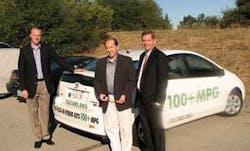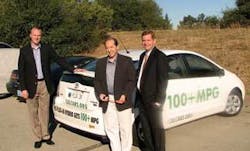Green is not a partisan issue
Paul Dickerson, US Department of Energy, Washington, DC
For the first time in our lives, being green is not a partisan issue. What used to be only about our environment is now about our economy and our national security.
By our calculations, America changed its mind on efficiency and renewables in 2005, motivated by high gas prices, the Gulf war, and global warming. It created a perfect storm across our country that caught the attention of consumers, legislators, and President Bush.
Our President has put America’s energy situation at the top of his agenda. He’s highlighted the issue in two consecutive States of the Union, putting it in a much broader context than it was previously understood.
In his most recent address, he said, “For too long our nation has been dependent on foreign oil. And this dependence leaves us more vulnerable to hostile regimes, and to terrorists...It’s in our vital interest to diversify America’s energy supply—and the way forward is through technology.”
You will note that the President goes beyond problem ID. He doesn’t merely sit back and complain about the challenges which face our environment, our economy, and nation’s security. Instead, he leads by setting bold goals.
In 2006, he gave us the Advanced Energy Initiative, which greatly expanded our efforts to change the way we power our homes, offices, and cars. This year, the President set the bar even higher with his 20 in 10 initiative to reduce gasoline usage by 20% by the year 2017.
The day following his State of the Union, and again last week, the President proclaimed by Executive Order that the federal government would no longer stand on the sideline when it comes to efficiency, but would finally lead by example, purchasing more plug-in hybrids, and establishing stricter regulations on auto emissions.
What’s interesting about the President’s approach is that while he has (1) set an ambitious agenda of developing alternative energy and (2) committed the country, by law, to the most aggressive energy efficiency program in our history, he continues to be clear that there is no silver bullet waiting around the corner—there isn’t a single solution or technology that will deliver on our goals.
Much of our nation’s progress will be incremental—even barely perceptible at times. Yet as stewards of our environment, economy, and national security, we must rise to these challenges and each do our part.
For his part, the President has turned to us at the DOE, asking that we think differently and quicken the pace. So that is what we are doing. In his policies, the President has made substantial bets on this nation’s scientists and business leaders.
To assist both communities, I have asked my team to 1) invest smarter our $1.5 billion research budget; and to 2) find ways to assist the business community. Now, $1.5 billion sounds like a large budget, and three years ago it was. But the market changed in 2005, with our nation at war and energy prices high, suddenly technologies that once were uneconomic became very attractive.
Today, our $1.5 billion budget accounts for less than 1% of the capital invested in renewable energy technologies. The rest comes from a vibrant and exciting private sector, looking to profit and drive America toward greater security.
So your DOE needed to wake up to its new reality. We needed to realize we were no longer the sole funder of these technologies and needed to find new ways to incent discovery and urge efficiency.
To invest smarter your tax dollars, we turned to our nation’s scientist, engineers, and business leaders in search of investment tipping points. As Matt Simmons and Chris Wolfe will tell you, I’m a business guy, not a scientist, so in broad strokes, I’ll share with you a few of the tipping points identified by our experts.
On plug-in hybrids, it’s all about lithium-based batteries. Once commercial, cars and trucks powered with this technology could displace 10% to 30% of our gasoline usage. But there are real challenges to overcome, as the current cost of lithium batteries is far too high.
To drive down these prices, we are looking for ways to lower the cost of (a) materials processing, (b) cell packaging, and (c) manufacturing.
For biofuels, it’s all about lowering the costs of feedstocks and enzymes.
You will recall that under the President’s 20 in 10 plan, we want to displace 35 billion gallons of gas with alternative fuels. Through our partnership with the Department of Agriculture, we are exploring a regional feedstock initiative, researching methods to increase crop yields, and looking to lower the costs of energy crops, like switch grass.
To make ethanol from wood chips or agricultural waste, we need less expensive enzymes. In February, the President visited Novozymes—one of a few companies that produce these enzymes—and learned how a DOE grant allowed that company to reduce the cost of conversion by a factor of 30.
And of course, we have found similar investment tipping points in solar, hydrogen, and our other technologies.
In addition to improving our investments, we have stepped-up our outreach to the business community.
Now, friends, you often hear how your federal government is isolated and hopelessly bureaucratic.
To fight this isolation and to allow business leaders to have greater access to their federal government, we are seeking to make our bureaucracy more transparent.
It is critical that our DOE staff keep their fingers on the pulse of the market, and equally important that we give entrepreneurs and CEOs a chance to peek behind the curtain of the federal government and spot for opportunity. Accordingly, I personally carve into my schedule eight meetings a week for business leaders like you—to come to DC, to meet our experts, and find opportunities to work together.
We started this program the week following this February’s State of the Union, and immediately filled the calendar through June, and the coming months remain very full. In the last 13 weeks, I have met with over 150 business leaders, delighted to interact with their government in this new way, and our staff has been equally excited.
One topic often discussed in these meetings is how the high cost of green technology continues to retard demand for these products. We are working to lower these costs and help companies sell more.
As my friends at Haynes and Boone know, I left the corporate practice to serve as chief of staff for the Department of Commerce’s Commercial Service—an amazing federal agency with a terrific mission.
The Commercial Service maintains a staff of over 1,200 employees in 180 cities around the world (including Houston), and their sole mission in life is to help US companies sell their products and services around the globe.
Your federal government, helping with business development.
We have no sales force at the DOE for your technologies, so soon after joining I asked the Commercial Service to become that sales force. One month ago, with their help, I hosted the federal government’s first ever clean-tech trade mission.
We sponsored 16 US companies in India and China, small and mid-sized companies like a consulting firm from Houston to large companies like DuPont and GE, each returning with new opportunities from these countries.
And let us not forget about our national labs. The DOE funds over eight labs across our nation—including the National Renewable Energy Lab (NREL) in Golden, Colo.
Now, a central challenge faced by these labs is similar to one faced by our nation’s universities—brilliant researchers are often not the best entrepreneurs. Accordingly, like universities, our nation’s labs maintain an impressive inventory of technology that has never seen the light of day.
To address this when I started at the DOE, I immediately hired three venture capitalists, forming the first ever commercialization team, asking that they dust off these inventions, push them to market – and it’s working.
Whether through our new entrepreneur-in-residence programs or through our technology fairs, we are pulling technology off the shelf and giving it to business leaders like you, so that you can finally get these valuable inventions to market.
Whether through our CEO meetings, our work to help you find customers for your products, or through our increased focus on commercialization, my friends, we are acting differently and helping US companies win.
You can rest assured that our office at the DOE will not stand back with our fingers crossed, hoping that the market will work its magic. Instead, we have changed our direction and we have quickened our pace.
We think this approach is the right one – by investing smarter and helping US businesses, we are recognizing the vital role of the marketplace in adopting new technologies and incenting further discoveries.
So, friends, I’m here to ask for your help. Whether you are motivated to help our economy, our national security, or our environment, we must all think differently. For whether it is next year, next decade, or 100 years from now, the earth will eventually demand new forms of energy – and we have no plans to sit back and wait for that moment of truth.
We have the ability, the intelligence, and – rare as it is in Washington – bipartisan commitment to do it and do it now. OGFJ
About the author
Paul Dickerson serves as COO of the Department of Energy’s Office of Energy Efficiency and Renewable Energy (EERE), which has a $1.5 billion annual budget. EERE invests in a diverse portfolio of energy technologies to provide clean, efficient, and renewable energy. Before joining the DOE, he was with the Department of Commerce. Prior to that he served as a corporate attorney in the Houston office of Haynes and Boone LLP.
EDITOR’S NOTE: This article is excerpted from remarks by Paul Dickerson, COO of the Office of Energy Efficiency and Renewable Energy, at the Haynes and Boone Energy Industry Conference in Houston on May 18.

